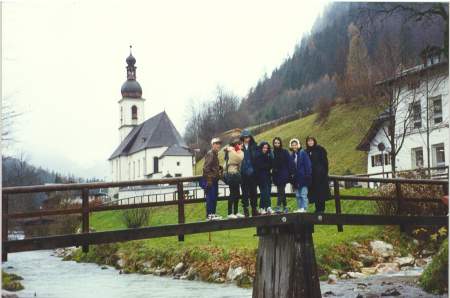
The adventure begins at just a few minutes past eight at Salzburg's Mirabelplatz. The RVO on the front of the bus clearly distinguishes it from the Salzburg city buses and marks it as the property of the Regionalverkehr Oberbayern GmbH. In less than thirty minutes the border crossing is over and the road moves gradually upwards into the foothills of the German Alps. At Marktschellenberg the rushing waters of a mountain stream begin to parallel the roadway and add to the scenery all the way to the Berchtesgaden station, which is reached by 8:45.
All the RVO buses terminate at either the train station or the post office in Berchtesgaden. Actually, the two sites are only about 50 feet apart, so to make the connection between lines terminating at the Bahnhof or the Post is an easy matter.
At about 9:00 Bus 9541 arrives from Bad Reichenhall and picks up passengers going to the Königssee, one of the most beautiful of Germany's Alpine lakes. The ride takes about 15 minutes with the bus stopping frequently to pick up school children. A short walk from the bus stop leads to the wharf and the ticket office for the electric boat ride on the lake. The clearness of the Königssee has been preserved by the prohibition of gas powered boats on the lake. The lake maintains its quiet serenity on bright clear days when the Watzmann is reflected in its waters, on rainy days when the towering cliffs along its sides are marked by hundreds of cascades, and especially on foggy winter days when an occasional glimpse of the snow through the mist serves as the only reminder that land is nearby.


Leaving from the Post office at 12:25 is Bus 9546 going to the Hintersee, but for this trip the destination is the Ramsau Kirche stop. The Ramsau church is an unspectacular building in a pretty but unremarkable Bavarian village, but the combination of typical architecture, a rushing mountain stream crossed by a simple walking bridge, and an impressive Alpine backdrop have made the Ramsau church the very symbol of Bavaria. After a short walk through the church yard and cemetery and a few dozen photographs, the vacationer can be back on the RVO and arriving at the Post Office by 1:30.
At 1:50 Bus 9540 returns to Salzburg, but the RVO day-traveler will get off only five minutes after boarding at the Salzbergwerk stop - note the difference in the spelling. Salzburg with a "U" is the castle of salt while Salzbergwerk with an "E" is the mountain of salt. And it is in this mountain of salt that miners have been going for hundreds of years. For the last several years, the owners of the Salzbergwerk have found just about as much profit from tourists as they have from salt.
For 12 DM or so one gets the privilege of donning miner's gear, boarding a tiny train, and riding into the bowels of the earth. There tour guides will explain the salt mining process in detail while leading you on a journey that includes two slides down slick wooden rails, a trip across a lake of brine, a movie theater cut into the rock, and a ride back to the surface on the same little train. For a few more coins, the tourist can have his picture (along with his fellow miners) mailed to him a few weeks later.
The entire experience takes a little more than an hour. Unfortunately, RVO does not have bus 9540 return to the station at a convenient time, so the traveler has to improvise, walking across the highway and up the hill to catch another line to the village of Berchtesgaden itself. The town is lovely and really deserves more than a couple of hours, but the last bus to Salzburg leaves the station at 6:25 arriving at 7:15. With a little luck there's still time to catch a concert in Salzburg before bedtime.
The best news of all is the cost for this trip. When boarding the bus at the Mirabelplatz, one should purchase a Tagesticket (day pass) for 13 DM. It covers all the bus travel for a 24-hour period. At the station a Fahrplan (schedule) can be purchased for less than 1 DM. There are dozens of alternatives to the itinerary outlined above, and each of them provides the same outstanding scenery that can be had from the $45 trip offered by Panoramic Tours.
Regional bus lines like the RVO are located all over Germany (and most other European countries) and almost all of them offer similar kind of day passes. Improvising and building one's own tour is not only a cost- saving measure; it often bring the best memories of a trip.